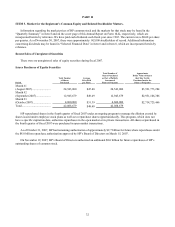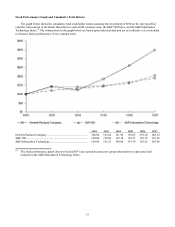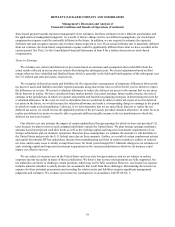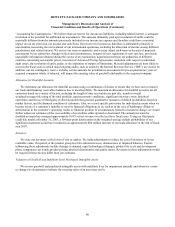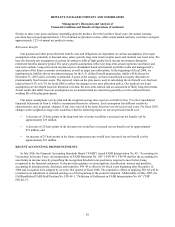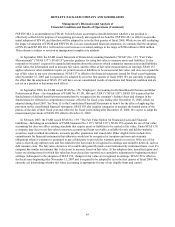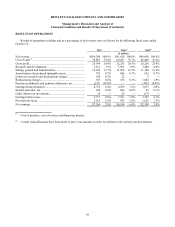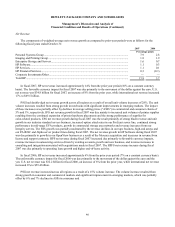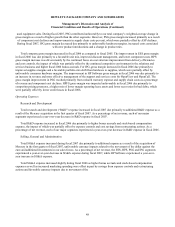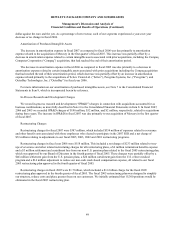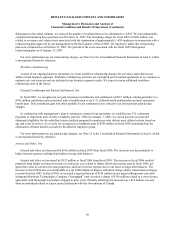HP 2007 Annual Report Download - page 56
Download and view the complete annual report
Please find page 56 of the 2007 HP annual report below. You can navigate through the pages in the report by either clicking on the pages listed below, or by using the keyword search tool below to find specific information within the annual report.HEWLETT-PACKARD COMPANY AND SUBSIDIARIES
Management’s Discussion and Analysis of
Financial Condition and Results of Operations (Continued)
90 days to three years parts and labor, depending upon the product. Over the last three fiscal years, the annual warranty
provision has averaged approximately 3.4% of annual net product revenue, while actual annual warranty costs have averaged
approximately 3.2% of annual net product revenue.
Retirement Benefits
Our pension and other post-retirement benefit costs and obligations are dependent on various assumptions. Our major
assumptions relate primarily to discount rates, salary growth, long-term return on plan assets and medical cost trend rates. We
base the discount rate assumption on current investment yields of high quality fixed income investments during the
retirement benefits maturity period. The salary growth assumptions reflect our long-term actual experience and future and
near-term outlook. Long-term return on plan assets is determined based on historical portfolio results and management’ s
expectation of the future economic environment, as well as target asset allocations. In the beginning of fiscal 2008, we
implemented a liability-driven investment strategy for the U.S. defined benefit pension plan, which will be frozen by
December 31, 2007 and is currently overfunded. As part of the strategy, we have transitioned our equity allocation to
predominantly fixed income assets. The expected return on the plan assets, used in calculating the net benefit cost, has been
reduced from 8.3% to 6.3% for fiscal 2008 to reflect the changes in our asset allocation policy. Our medical cost trend
assumptions are developed based on historical cost data, the near-term outlook and an assessment of likely long-term trends.
Actual results that differ from our assumptions are accumulated and are amortized generally over the estimated future
working life of the plan participants.
Our major assumptions vary by plan and the weighted-average rates used are set forth in Note 15 to the Consolidated
Financial Statements in Item 8, which is incorporated herein by reference. Each assumption has different sensitivity
characteristics, and, in general, changes, if any, have moved in the same direction over the last several years. For fiscal 2007,
changes in the weighted-average rates would have had the following impact on our net periodic benefit cost:
• A decrease of 25 basis points in the long-term rate of return would have increased our net benefit cost by
approximately $33 million;
• A decrease of 25 basis points in the discount rate would have increased our net benefit cost by approximately
$51 million; and
• An increase of 25 basis points in the future compensation rate would have increased our net benefit cost by
approximately $21 million.
RECENT ACCOUNTING PRONOUNCEMENTS
In July 2006, the Financial Accounting Standards Board (“FASB”) issued FASB Interpretation No. 48, “Accounting for
Uncertainty in Income Taxes, an interpretation of FASB Statement No. 109” (“FIN 48”). FIN 48 clarifies the accounting for
uncertainty in income taxes by prescribing the recognition threshold a tax position is required to meet before being
recognized in the financial statements. It also provides guidance on derecognition, classification, interest and penalties,
accounting in interim periods, disclosure and transition. FIN 48 is effective for fiscal years beginning after December 15,
2006 and is required to be adopted by us in the first quarter of fiscal 2008. The cumulative effects of applying FIN 48 will be
recorded as an adjustment to retained earnings as of the beginning of the period of adoption. Additionally, in May 2007, the
FASB published FASB Staff Position No. FIN 48-1, “Definition of Settlement in FASB Interpretation No. 48” (“FSP
FIN 48-1”).
42


